NEW DATA: Black Friday 2020: COVID-19 Steepens Physical Retail’s Long Slide

The divide between digital and brick-and-mortar commerce hit a tipping point this holiday season, with more consumers than ever going online to kick off their holiday shopping sprees. Three out of every four consumers who shopped for their holiday purchases on Black Friday this year made at least one of those purchases online, and three in 10 exclusively shopped online.
This massive shift away from the early-morning shopping and long lines of Black Fridays past was arguably inevitable, and consumers’ desire to avoid brick-and-mortar stores this year has played a clear role in driving it.
What is less clear is whether this trend toward digital-first holiday shopping will stick. Will Black Friday 2020 mark the beginning of a new, digital-first holiday shopping tradition, or will consumers return to their block-long queues after the pandemic has subsided and they are once again free to shop in stores?
This is the first of many questions that PYMNTS sought to answer in the new Black Friday 2020 Report: Crossing The Digital-Physical Shopping Divide. We surveyed a census-balanced panel of 2,147 U.S. consumers on Nov. 28, 2020, to find out how they are commemorating the traditional kick-off of the holiday shopping season.
This is what we learned.
Digital-first consumers, used to shopping this way, just kept doing what has worked for them since the early days of the pandemic: shopping online and getting online purchases delivered. Three in four shoppers bought items online and three in 10 shoppers bought items exclusively online.
The COVID-19 pandemic accelerated consumers’ shift to digital-first commerce. These shoppers have since taken the digital shopping habits they adopted in the wake of the pandemic and used them to bring their Black Friday game plan to the next level. Our research shows that 74.1 percent of holiday shoppers bought or plan to buy their holiday purchases online in 2020, representing a 12.7 percent increase from the share who did so in 2019. It is also 27.1 percent more than those who shopped online on Black Friday in 2018, demonstrating the continuation of a much longer and broader transition that has been driving more consumers to shop online with each passing year.
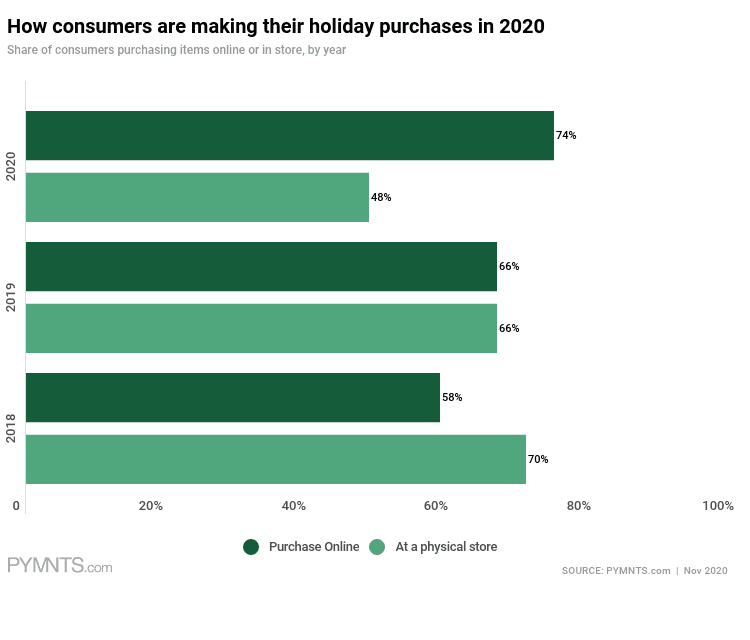
Consumers not only shopped online more than ever before, but many avoided shopping in-store altogether. Only 15 percent of all consumers who kicked off the holiday shopping season this Black Friday shopped exclusively in stores, a 25.7 percent decrease in the share of consumers that made their Black Friday purchases at a physical store in 2019 and a 41.4 percent decrease in the share who did so in 2018.
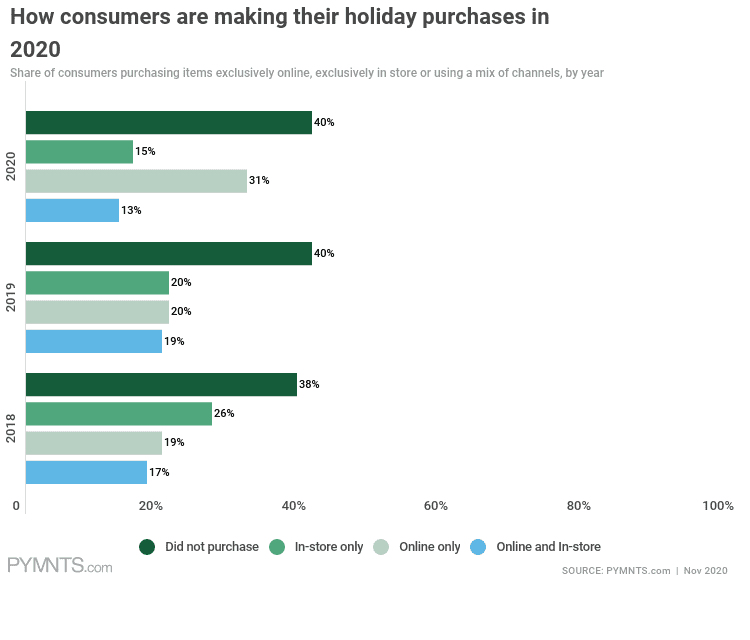
Convenience played a key role in keeping holiday shoppers online and out of the store. Concerns over COVID-19 were present but were secondary to consumers who craved convenience.
Consumers who planned to do some of their holiday shopping online this year said they did so primarily because shopping online was easier and more convenient than shopping in stores. Our research showed that 67.6 percent of all holiday eCommerce shoppers used online channels for this reason, compared to 47.4 percent who cited the fear of COVID-19 infection as their reason. Product availability rounded out the top three holiday eCommerce drivers. Our survey findings indicate that 47.6 percent of consumers who shopped online this Black Friday did so because there is greater product availability online than in stores. Other major reasons holiday shoppers gave for doing their shopping online this year included being able to access lower prices, it takes too long to get in and out of stores and believing that data security was stronger online.
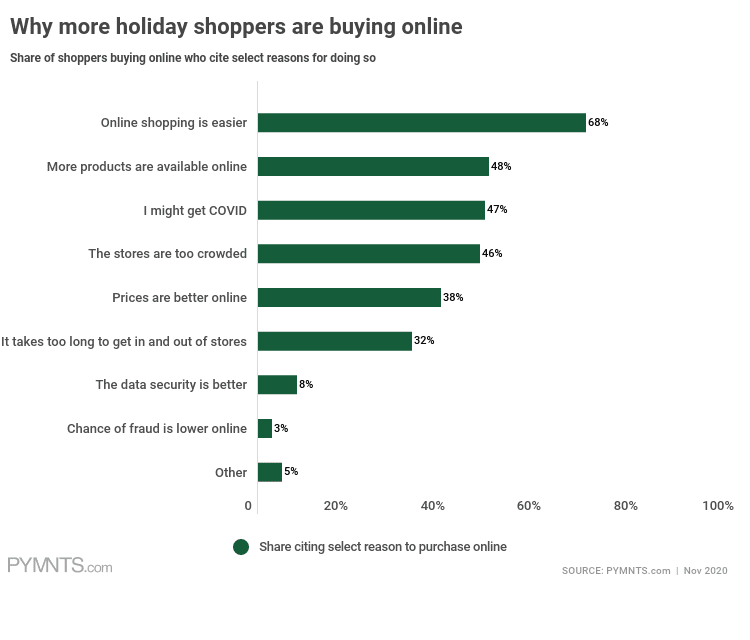
Most consumers find it just as easy to buy items online as in-store, with the notable exception of high-value items. Jewelry stands out as an item that consumers want to be able to inspect in person before making a purchase.
Consumers’ propensity to shop for Black Friday purchases online was up across the board, but there were still certain items that they preferred to buy in person. This was particularly true when it came to buying jewelry, whose quality can be difficult to decipher online. Twenty-eight percent of all Black Friday shoppers bought jewelry in brick-and-mortar stores this year, compared to 21 percent who bought jewelry online.
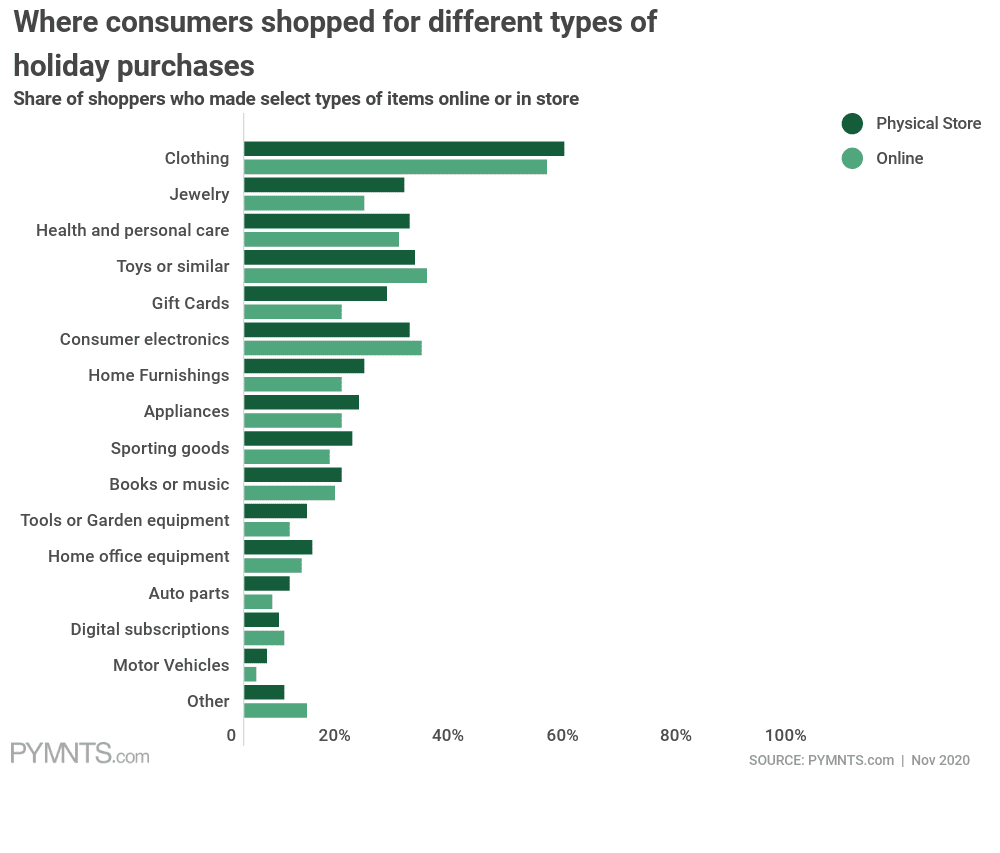
Overall, the physical-digital divide was evenly split when it came to buying more routine items whose quality was similar, regardless of where it was purchased. Fifty-six percent of Black Friday clothing purchases were made in-store this year, while 53 percent were made online, for example. Shoppers also bought health and beauty products in similar numbers online and in-store, with 29 percent of shoppers who bought such products on Black Friday in-store and 27 percent having bought them online. This shows that consumers generally saw online purchasing as a viable substitute for brick-and-mortar shopping, with the exceptions of a few key items.
More consumers used debit cards and PayPal to shop on Black Friday this year.
Consumers used a more diverse array of payment methods to make their Black Friday purchases in 2020 than they did in 2019, with debit cards being the most commonly used payment method of all. Debit cards surpassed credit cards as the most common method in-store shoppers used to pay for their Black Friday purchases, in fact, with 48.6 percent using them to pay in physical stores this season — up 15 percent from 2019. This compares to 45.1 percent of Black Friday eCommerce shoppers who paid via credit card.
Debit card usage was also up among Black Friday shoppers that made purchases in brick-and-mortar stores, but it was still less commonly used than credit cards. Our survey shows that 39.7 percent of Black Friday shoppers who made at least one-holiday purchase online this season did so using their debit cards, up 7.3 percent from last year. This compares to 54.3 percent who paid using credit cards this year.
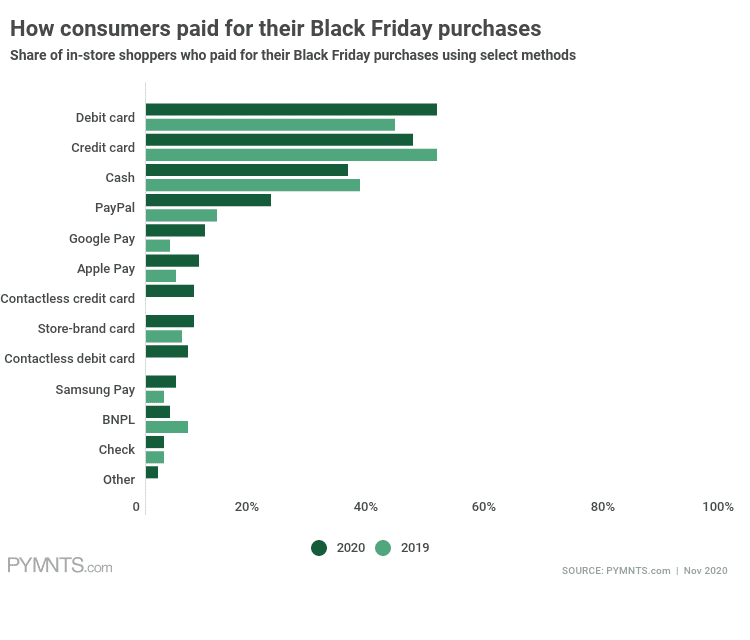
More Black Friday shoppers paid via digital wallets in 2020 than they did in 2019, both in-store and online. Consumers’ usage of digital wallets such as PayPal, Google Pay, Apple Pay and Samsung Pay was up this season, with Google Pay and PayPal being the most commonly used digital wallets for in-store and online purchases, respectively. More than twice as many Black Friday shoppers paid for their in-store purchases using Google Pay in 2020 than they did in 2019, and 14 percent more paid for their online purchases via PayPal than did last year. This worked out to 5.5 million (9.7 percent) of all in-store Black Friday shoppers paying via Google Pay and 25.1 million (28.5 percent) of all online Black Friday shoppers paying via PayPal.
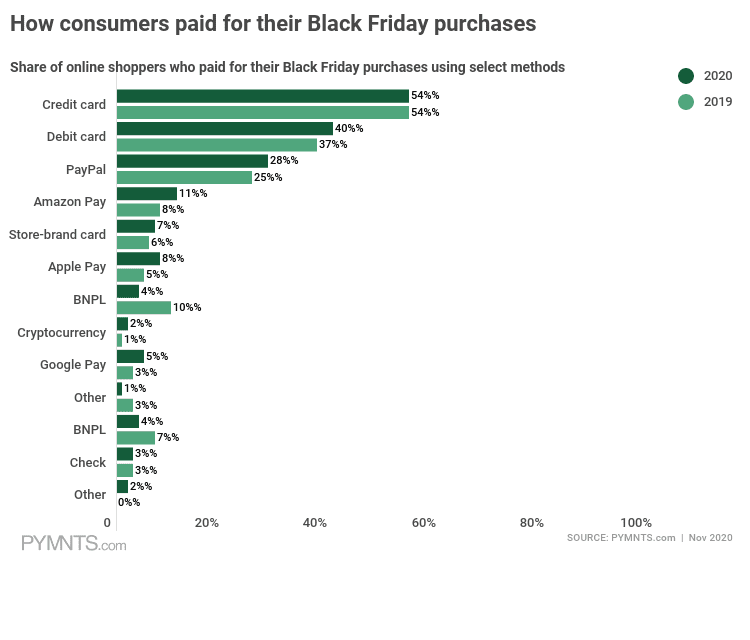
More than half of holiday shopping has already taken place. Only 45 percent of holiday shopping is expected to happen after Black Friday.
Merchants are now in a battle to win over the remaining 45 percent of holiday spending that is expected to happen by the end of this year. Consumers pulled ahead of schedule in their holiday spending this year, with consumers having spent 55 percent of their holiday expenditure either before or on Black Friday. The pressure is on for retailers to switch up their holiday game plans to appeal to the shopping and payment needs of the remaining digital-first holiday shoppers.
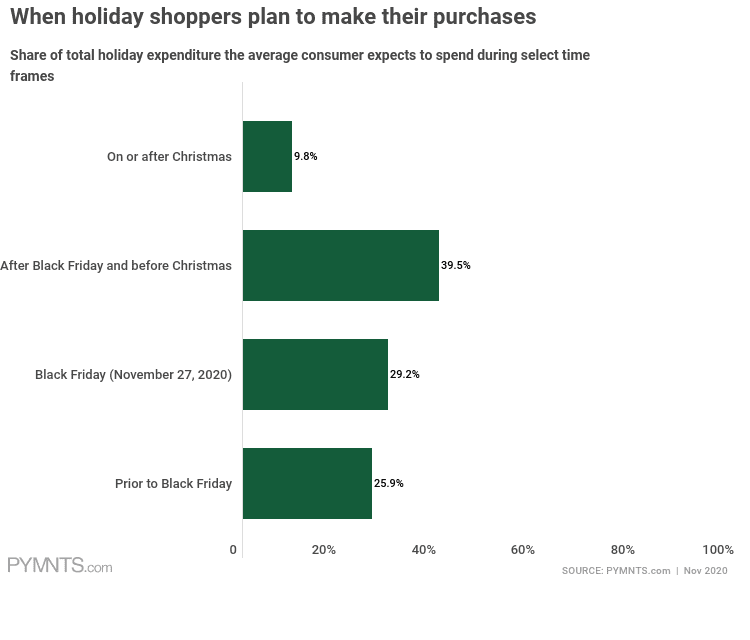 Conclusion
Conclusion
Black Friday has gone digital, and it is likely to stay that way. Holiday shoppers have been slowly but surely shifting away from physical stores toward digital shopping channels for years, and the COVID-19 pandemic has only accelerated this trend. Consumers have come to enjoy and even expect speed and convenience of shopping for holiday purchases online. It is clear that once the dust settles on the 2020 holiday season and consumers return to their routines, their preference for digital-first commerce is unlikely to fade.
